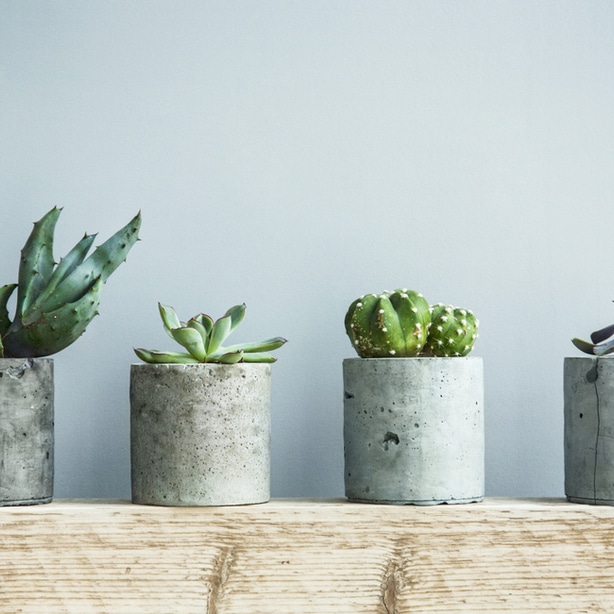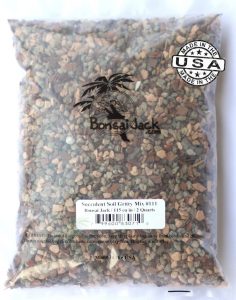Without the right soil, your cacti do not stand a fighting chance in flourishing. Too many owners either overwater or buy poor quality soil found in their local gardening stores. They end up spending hours (and tons of money) trying to troubleshoot issues. Prevent all of it by starting out with the highest quality potting mix.
If you have trouble growing cacti, then you are either watering too much or you have soil that is not conducive to growth. The potting mix needs to be well aerated and drain well. Many companies try to sell potting mixes with cheaper ingredients. As a result, they do not drain well and will lead to root disease (or root rot).
Make sure to check out our articles on raising houseplants. We have guides on raising different succulents such as how to take care of a paddle plant.
Use these reviews and the guide below to make sure you are watering properly and have the ideal growing conditions. It will set you up for success.
Our Top 3 Recommendations

At A Glance
- Bonsai Jack Succulent and Cactus Gritty Mix
- Fat Plants San Diego Premium Organic Cacti and Succulent Soil with Nutrients
- xGarden Cactus and Succulent Mix
- Perfect Plants’ All Natural Succulent and Cactus Mix
- Hoffman Organic Cactus and Succulent Mix
These are our top recommendations. They all have great organic to mineral components and provide great aeration to the roots. Because they drain very well, they also will help prevent root rot. Your cactus will be thanking you and start flourishing. Read more below.

Best Soil for Cacti
Bonsai Jack Succulent and Cactus Gritty Mix
Bonsai Jack is our top pick. It is a very gritty mix which includes pine bark as the organic component. It is designed so that there is a consistent particle size. Because of its coarse pieces, it is excellent at draining and preventing root rot. Furthermore, it is ultra-lightweight and will ensure proper aeration to the roots. The product is optimized to a pH of 5.5 and is pathogen free.
Bonsai Jack’s product is made in the USA with quality ingredients. Many other brands use reclaimed organic matter that may still contain pathogens that can be damaging to your plants. Bonsai Jack is pre-washed and screened. The company itself also provides great support and is responsive to any issues. They provide a satisfaction guarantee or your money back.
Once your plants are transplanted into this mix, you will see that they will flourish and thrive like you have never seen before. Not only will you see amazing growth, your plants’ roots will also be healthy. Other products simply cannot compete.
Fat Plants San Diego Premium Organic Cacti and Succulent Soil with Nutrients
Fat Plant’s product uses premium quality soil that is pH balanced. It uses a super fine coco coir with small pumice added in that drains exceptionally well. Unlike many of the other products, it does NOT contain coarse sand or grit. Rather, it almost feels like a cotton-like material, which is how it has such great aeration and also drains lightning fast.
This product is packaged in San Diego. The company is responsive and also adds a personal touch of a handwritten message when you open up the package.
xGarden Cactus and Succulent Mix
xGarden’s potting product has good drainage and is pH controlled. It contains a blend of peat moss, vermiculite, and perlite. It is relatively light weight and provides good aeration to the roots. It comes ready to use and will help your cacti grow healthy. If you want to make it drain even better, you can consider adding orchid bark or coco coir chips, which will also make the soil more porous. Nonetheless, it will work very well regardless.
Perfect Plants’ All Natural Succulent and Cactus Mix
Perfect Plant’s product is formulated to provide good aeration to the roots and retaining nutrients. It is composed of garden coir, composed pine bark, perlite, and sand. I will say that it can be slightly faster draining than it is. After watering, water seems to sit on top of it for a while before slowly being absorbed. It is still a good product, but there are other mixes, such as those above that provide better drainage, and thereby minimize the chances of root rot.
Hoffman Organic Cactus and Succulent Mix
Hoffman’s organic product is a premade mix that comes ready to use. It is relatively light weight and provides decent aeration to the roots. The only downside is that it contains peat moss, which actually will retain some moisture. This means that you can wait longer periods of time between watering. I personally find it harder to predict and think that it can make your cacti more prone to root rot. I still think it is a good product, but with so many other options available I suggest you pick one of our top 3 choices instead. If you do end up using it, you can add more perlite to increase aeration and drainage.

Make sure to also check out our devil’s ivy care guide.
What Kind of Soil Do Cacti Need?
Think about a cactus’s natural habitat. It is dry and hot. It gets water infrequently, but when it does, it gets flooded with water for a short period of time.
This is exactly what you want to simulate when finding potting mix. It should contain some organic material, but be very sandy, or porous. This will allow the potting mix to drain well and provide good aeration to your plant’s roots.
The most common reason cacti die is because of excessive watering or poor potting mix. In both of these scenarios, excess water sits at the roots. This leads to root rot which ultimately will slowly cause your plant deteriorate.
Once root rot sets in, it is difficult to reverse. So it is important to start with great soil and good watering habits.
If you only have one or a few cacti, then I highly recommend that you buy one of the products above. Not only do they have our highest recommendations, but they are also very affordable. They use quality ingredients and tend to have coarse gritty inorganic materials, which allows for optimal drainage.
You can also make your own mix, but if you do not have many cacti, you end up having a lot of extra soil laying around. If you want to keep some for future plants, this may make sense, but generally it is easier just to buy the pre-made mixes.
What is Root Rot?
Root rot is a condition, that if left untreated will destroy your cactus. Because the root rot first starts within the soil, most gardeners are not aware of the problem until it is advanced, and too late. Symptoms that may start to appear include stunted growth or dead leaves.
Once you notice root rot, you need to take action immediately. You likely will need to repot your plant to give it a fighting chance.
The easiest way to prevent headaches associated with root rot is to just get soil that drains well. Soil that is too dense will retain water and allow your plant’s roots to soak in water. This is a breeding source for bacteria and diseases. Cacti, in particular, are prone to root rot. Their natural habitats do not expose them to a lot of water, so they do not have some of the defense mechanisms that other plants may have.
Balance of Organic and Mineral Components
Good potting mix will contain both organic and inorganic (or mineral) components. Organic components refers to things that contains compounds that used to be alive. Mineral components, on the other hand, refers to things that are not made of living substances.
Organic components include things such as general all-purpose soil, pine bark, coconut coir, and compost.
Mineral options include coarse sand, perlite, fine gravel, and chicken grit. You’ll want to avoid mineral components that store water; steer clear of vermiculite and clays.
In all of the products above, there is a good balance of organic to inorganic material. In a similar manner, if you want to create your own soil, you will use a combination of organic and inorganic material

Making Your Own Potting Mix
As I said earlier, I encourage you to buy one of the products above. They are very affordable and use quality materials.
If you are set on making your own potting mix, then you can use the recipe below. Just realize that you may be creating more work for yourself and it will likely yield a lot more mix than you will need. You can always keep the excess in storage for when you need it again.
Suggested recipe:
Simply combine these three at a 1:1:1 ratio in a large bowl or container.
Use Pots with Draining Holes
If at all possible, plant in a pot with a draining hole at the bottom. Without a draining hold, still water will just sit at the bottom of your potting mix. Again, this puts your succulent at a high risk of developing root rot.
Unfortunately, nowadays, many pots and terrariums do not have draining holes. It is undeniable, a glass bowl terrarium is spectacular to look at. However, without the draining hole, your cactus will have difficulty thriving. Furthermore, bowl terrariums tend to create a greenhouse type of effect where a lot of humidity accumulates in the bowl. This is, again, not an ideal environment.
If you cannot resist using a pot or terrarium without a draining hole (I get it), then make sure to water very sparingly. It will be difficult to water just the right amount, but try to err on the side of less water.
Soak and Dry Watering Method
The ideal way to water is to use a method called “soak and dry”.
It’s rather simple. Just soak the soil completely and then let it dry out completely before watering it.
When you are doing this method, try not to let water get onto the cactus itself. Also, try to water in the morning so that any water that does land on the plant can evaporate after exposure to the afternoon sun. This will also give your soil time to drain and dry out because of the sun.
You can check out this Youtube video (not created by GreenPinky) for a quick visual guide on how to water your succulent appropriately.
Bottom Line
Again, I recommend buying the Bonsai Jack mix. Don’t make the mistake of buying a cactus soil at your local gardening store that does not drain well and will lead to root rot. Save yourself the headache and buy any of the products above (take a particularly close look at our top 2 recommendations which drain the best).






